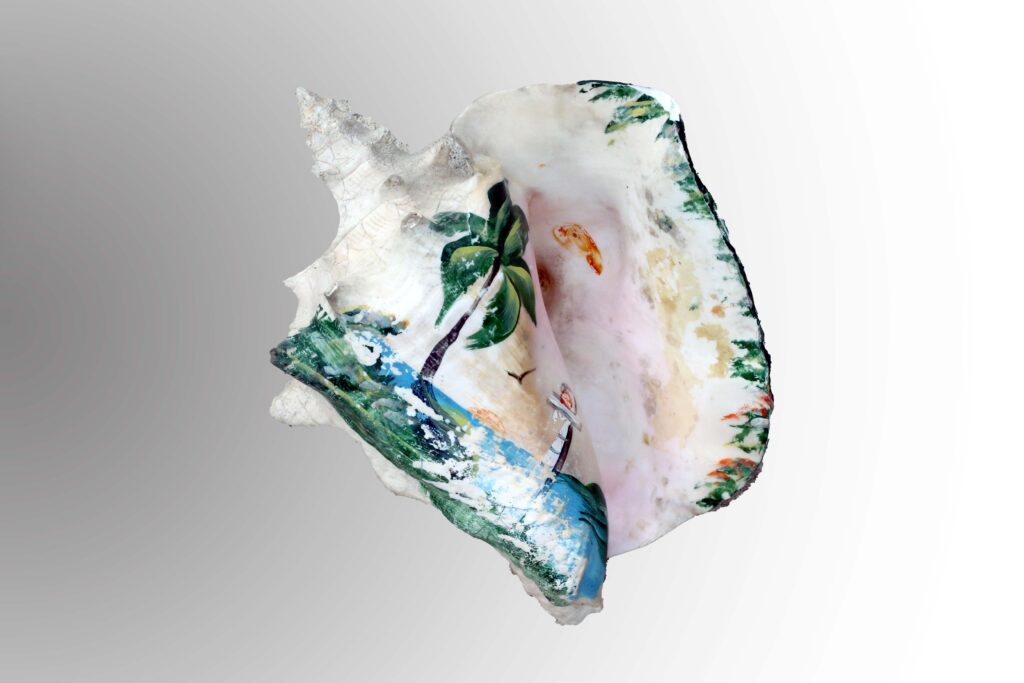A child’s friend turns out to be not so imaginary

The shell’s faded colors and chipped paint reflect the long, full history it represents.
Feb. 1, 2022 | Story by Avery Lotz | Photos by Julia Mitchem
Many children have imaginary friends, and I was no exception. Mine lived inside a conch shell.
Around the time I turned 4, he started to appear. Every night, as I squeezed my eyes shut and pulled up my sheets, I made a wish: I hope he visits me.
Seconds passed. Maybe minutes. Maybe hours.
The conch shell on my bedside table, a family heirloom decorated with pastel brushes of decades-faded paint, became a wrinkled movie screen. The seaside scene painted on its surface came to life and crashed with the rise and retreat of the waves. Like a genie from a golden lamp, a shadow of a man poured from the thin end of the nearly foot-long conch. He had arrived.
The shadow man was calm. He solidified into a crouched figure in the dark corner of my room and tiptoed over the miniature bunk bed where my American Girl doll Josefina lay.
His gray tweed pants hung around knobby knees; he must’ve been plagued with an old man’s aches in life. His cotton-ball hair stuck out in all directions and reached for the ceilings and my lime green walls. He moved toward me and then perched in the chartreuse vinyl chair next to my bed. His eyes and his mind always seemed to focus on different things. Some nights we spoke. But most nights, he just sat.
I took in his voiceless wisdom; I could almost hear his thoughts splashing in his mind.
Maybe he was a fantasy. Maybe he was, as my distant ancestor Charles Dickens would’ve said, an undigested piece of meat. Maybe he was a residual spirit haunting my childhood home.
My imagination made any figment of wonder seem like reality. I saw fairies in the magnolia trees, heard dragons roar when the wind blew and told my father his white sedan was not merely a car but a wizard trapped in a motorized cage.
The shadow man felt different.
I never feared him. His passive gaze was a safety blanket. Though I did not know his name, his wrinkled face felt familiar.
Even now, his image is the wallpaper of my restless mind.
When I was born, the conch shell sat in my nursery. It was about the size of me back then. The waves painted on its side taught me the vastness of the sea while the concrete castles of Atlanta outside my parents’ home swallowed my childhood.
By the age of 6, I grew to expect him in the restless hours past my bedtime. It was our routine: I stared at the shell until sleep carried me away or his figure stole my attention. I don’t remember much of our hushed conversations, but I know he never identified himself. He was my nameless secret guardian.
After I turned 9, I saw him less and less. Some nights, I wondered if I heard him, but by the time I flung my body in the direction of his corner, he was gone — if he was ever even there. I didn’t know how much he meant to me until his visits stopped. His absence made me more terrified than his presence. I was alone.
I barely slept. When I was 10, I confided in my mother about why I couldn’t sleep.
“An old man visits me sometimes,” I confessed to her. Her eyes widened in confusion as she choked on a sip of coffee. “He comes — or he came — out of my conch shell at night.”
I was at an age when the line between imagination and reality was still blurred, she says; she thought little of my words. Distracted by a stain on our ivory couch, she played along.
“Like a genie?” she implored.
“Yes!” I exploded. Maybe she had seen him, too! “Have you met the man with Albert Einstein hair?”
Her back straightened, and she fell to silence. She had met the man with the wild white locks. She watched him chew on unlit cigars and bicker with his wife in the way only old married couples can.
Roy Lancaster “Poppop” McNab.
Mayor of Flagler Beach. Flight instructor for the Royal British air force. Grandfather to Jennifer, great-grandfather to me. Late-night counselor. Albert Einstein look-alike.
Dead. A faded face on a family tree. A shadow man.
In 1995, old age took him from the world; he left behind a wife, four daughters, two sons — and a shell.

Once perched at her childhood bedside, the shell has remained a physical reminder of the author’s ancestry and familial history.
In 2000, my mother walked the steps her grandfather once did in his Flagler Beach home. She crept down the stairs from the living area to the storefront just below: the general shop Poppop McNab once owned. Boxes of leftover trinkets and toys meant to charm tourists collected dust below the wide windows. A curved taupe shape caught her eye.
She stooped to reach into a box.
“Do you want it?” my grandmother asked behind her, watching her pregnant daughter lean sideways to avoid her growing stomach. “You could put it in the peanut’s room.”
My mother stood, her prize in her swollen hands: A conch shell painted with a beach scene that her grandfather sold versions of in his store.
After 20 years, the shell has moved with me to college. It still sits on my bedside table, though it never produces apparitions like it used to. Now, the conch rests in a sea of succulents and feels the warmth of different candles as the seasons pass. Yet it is more than a simple decoration: It is a reminder of who I am and that someone — even in death — will always care about me.
In Scotland, where the McNabs trace our family’s lineage, conch shells are often placed on the tops of gravestones. The weathered objects that once served as safe havens for indefensible, soft creatures sit atop the cracked stone to signal a living family member made a long pilgrimage to visit their deceased.
The tradition traces its roots to African cultures.
A Haitian priest, quoted in “Africanisms in American Culture,” says that conch shells “symbolize the existence of the spirit in the sea… It symbolizes the animation of succeeding generations by the spirit of the ancestors.”
But it’s the belief of the Kongo people that make me wonder if my visitor was merely a figment of imagination or a once-living relative. They say the conch shell holds the dead’s immortal soul. Listening to the shell is a way to communicate with those they’ve lost.
In these cultures, placing a conch on the grave preserves the memory of a life.
I will keep Poppop McNab’s legacy alive. To the man I know yet never met in life, the spirit who bestowed pride in my family name within me, the guardian angel who defeated my childhood fears of the unknown: I will not forget you.
I no longer see him, hear him or call out to him. But I feel him. I know now that he was never an imaginary friend.
In Flagler Palms Memorial Gardens, two plots are a marriage bed for Roy and his Winifred. Forever they sleep beside one another.
And on their shared gravestone, I left behind a pair of trinkets. Two conch shells, pearly white and shining. On each, I painted the ocean.
Avery Lotz is Atrium's co-Editor in Chief and Print Editor. She has written for CNN, WUFT News, The Independent Florida Alligator and Her Campus UFL. In her free time, she enjoys surfing, painting and exploring the Sunshine State.
